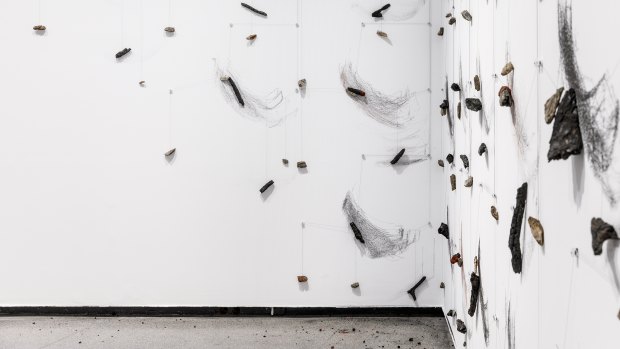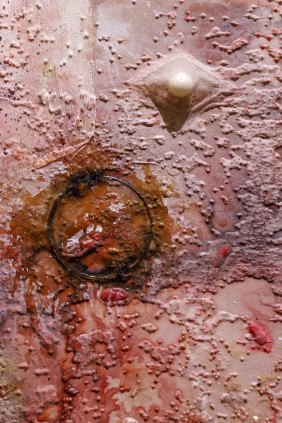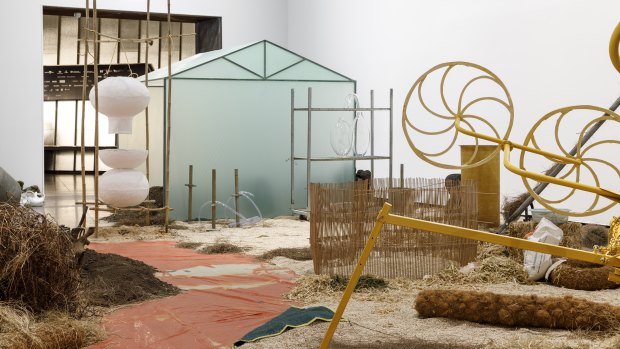By Robert Nelson
ART
Overlapping Magisteria
ACCA until 15 March
There’s an ingenious drawing machine at ACCA. On a raised platform, an armature pulls at 100 strings in a linear backward and forward motion. The strings run up the wall, fly across the space and tug at pieces of charcoal moored to the opposite wall.

Tracing inscriptions 2020, installation viewCredit: ACCA / Robert Andrew / Andrew Curtis
The resulting drawings resonate with one another in analogous actions. The spectacle is engaging, as you try to work out the engineering: how do the strings coordinate the curved gestures on the wall? On a symbolic level, the work is tantalising. It’s like an allegory in which divine will is perfectly organised and controlled by a matrix, but perfect compliance does not eliminate chance and chaos.
Robert Andrew, the artist, has special reasons to devise this astonishing contraption, called Tracing inscriptions. He feeds in words from the language of the Yawuru people in the Kimberley, from whom he’s descended. The mechanically driven drawings are executed by charred wood from bushfires.
But you’d never understand the translation process just by looking at the work.
For me, there are too many strings attached to the machine to be a simple code generator. It looks like God’s harp, and the artist plucks on the cords to unsettle the independence of whatever dangles from its perfection.
The work is one of five that ACCA commissioned in a show called Overlapping Magisteria. This mouthful comes from a concept, “non-overlapping magisteria”, hatched by Stephen Jay Gould to identify a natural barrier between science and religion. The theory has it that science is hemmed by empirical data, while religion or spirituality is devoted to moral and emotional phenomena. They don’t overlap.
Alas, whenever science makes incursions into psychology or the origins of life, this separation seems illogical. For a scientist, a process of chance in evolution, say, directly contradicts a belief in divine providence. Science and religion cannot be reconciled by keeping them apart. The theory supposedly rescues the integrity of both but in fact recognises the claim of neither.

Closed eyelids 2020, installation viewCredit: Mimosa Echard / ACCA / Andrew Curtis
Given the medieval gravity of the title, you might have expected that Overlapping Magisteria would contemplate how science and faith parley with one another, but the show is about other things. Robert Andrew’s work is the only one that can be read as a comment on the handwriting of God. The other works have little or nothing to do with the diplomatic stand-off between theology and science.
Instead, it’s all about how the works overlap in their evocations of the body, the material and the abstract. But the overlap that I noticed most tellingly was the dependence that the artworks have upon the essays written about them.
Without the informative essay by Robin Eames, I would have had no idea that the installation of Sam Petersen contemplates disability. On its own, the plasticine placed in gaps in the gallery’s architecture doesn’t give much away.
Without the essay by Marion Vasseur Raluy, I wouldn’t have connected the busy works of Mimosa Echard with tears and other body fluids. There are many beads embedded in paintings and dangling in shafts but I missed the secretions.
Without Ellen Greig, I wouldn’t have guessed that Sidney McMahon’s fan-forced black sails relate to armour, and the connection with the videos still escapes me.

Ogives 2020, installation viewCredit: Isadora Vaughan / ACCA / Andrew Curtis
Maybe without Abbra Kotlarczyk, I would have gleaned that Isadora Vaughan’s farmyard assemblage refers to transformations by analogy to agriculture; and maybe it could be described as “a tumescent thicket of odes to bodies and places”. Actually, I think that might have been a better title for the show as a whole.